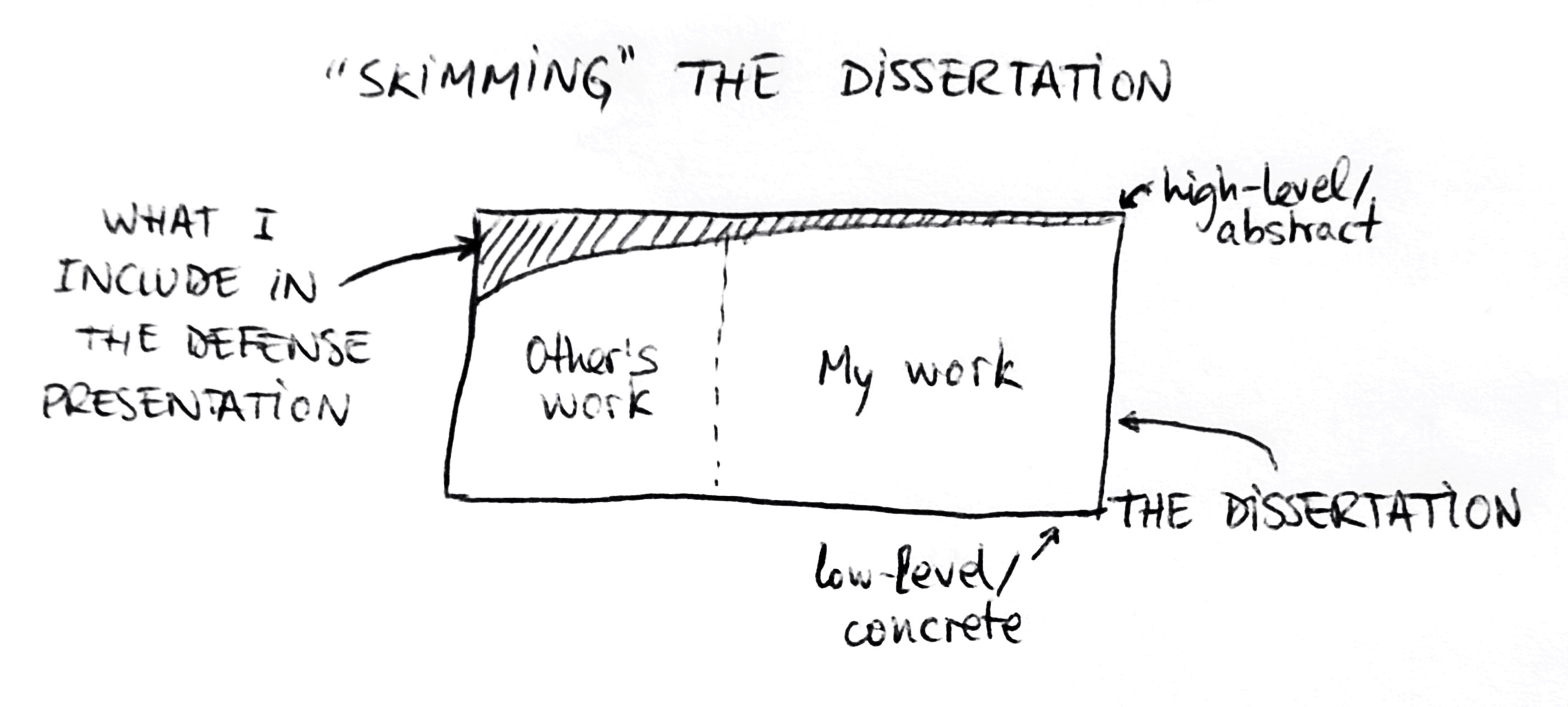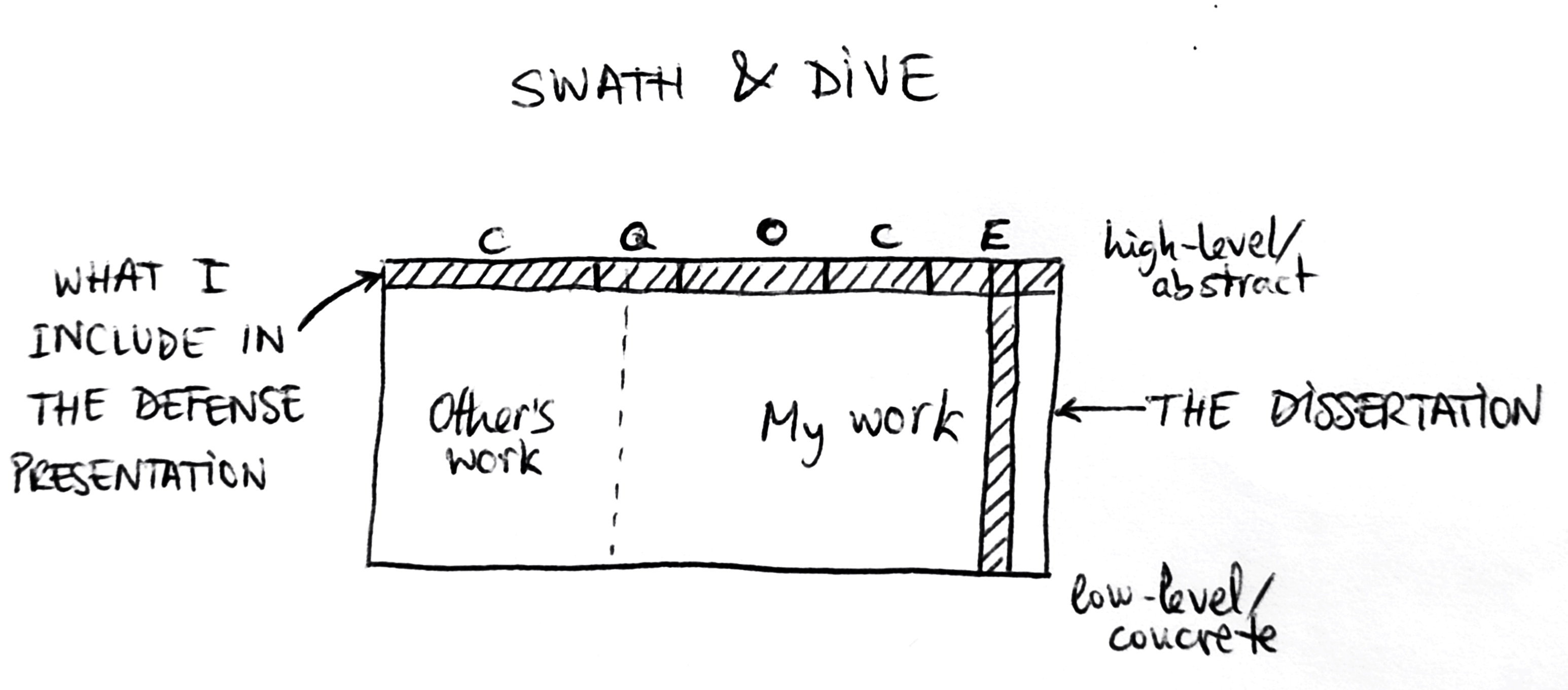How to Pull Off Your Thesis Defense With a Great Presentation

You’ve reached the home stretch in your journey toward your post-graduate degree. You’ve diligently studied, researched and performed for years, and all that’s left is your master thesis or doctorate dissertation.
“ All that’s left,” however, might be the understatement of the century. There’s nothing simple about orally defending your thesis, and this final stage often means the difference between a degree and a program that remains incomplete.
Even after you’ve dedicated months filled with blood, sweat and tears defining your argument, researching your support and writing your defense, you aren’t ready to address the academic panel. You still have to design an effective visual presentation, and the slide deck can make or break your entire thesis.
Unsure how to design a stellar slide deck to visually present your thesis or dissertation? Check out the following tips to pull off your master thesis defense with a great presentation:

1. Properly structure your slide deck
Every master thesis defense presentation is unique, but most effective slide decks will follow a similar structure, including:
- Title - Just like a research paper, your thesis presentation must include a title slide. This should include the same information as any other title page: the title, your name, your academic institution, course name and the name of the academic advisor to your thesis or dissertation. That doesn’t mean your title slide needs to look like the start of any other Frankendeck . Instead, add your text atop a relative image, and adjust the brightness to ensure your text pops.
- Introduction - Your thesis presentation should also include an introduction slide, which details the topic of your thesis, the question your research will seek to answer and any additional objectives to your research, as well as the answer or solution you will be defending.
- Literature review - Following your thesis introduction, design one or more slides that review the literature you researched. This shouldn’t be a full bibliography (although that should be included in the accompanying written account of your research), but instead, the slides should list your most relevant research sources. If the information is featured on a slide, make sure you include its source.
- Methodology - Your thesis presentation slide deck should also include a slide (or slides) detailing the methodology of your research and argument. Here you want to describe the type of study— whether it’s quantitative, qualitative or a combination of the two, as well as an explanation of why you chose the method or methods you used. If you conducted original research, you will want to detail the study population, sampling methods and other details pertinent to your studies, while you’ll also want to detail how you analyzed your data.
- Results - No thesis presentation slide deck is complete without dedicating slides to illustrate the results of your research. Be sure to include a description of any data you collected through your research, as well as the results of your analysis of the data. What were your most significant findings?
- Discussion - How do the results of your research support your overall thesis argument? Be sure to include slides that discuss your overall findings and how they relate to your original question.
- Conclusion - Concluding slides should restate your original research questions, represent the results of your research, suggest future research and make any final recommendations.
- Ending slide – Close your thesis presentation with a concluding slide that offers an interesting quote or trivia that makes your audience further ponder your topic, a GIF or animation that recaptures the audience’s attention or even a hypothetical question that opens additional discussion from the academic panel. This is your opportunity to make your presentation memorable.

Thesis Presentation vs. Dissertation
Thesis presentation and dissertation are two terms often used in academic settings related to upper education. While they are related, there are distinct differences between the two, which is important to understand as you begin to structure your thesis defense.
A thesis presentation typically refers to the final oral presentation that a student gives to defend their thesis or research project. It is a formal presentation to explain their findings, methodology, and conclusions to a panel of faculty members or experts in the field. The purpose of a thesis defense presentation is to demonstrate the student's knowledge and understanding of the subject matter and to defend the validity of their research.
On the other hand, a dissertation refers to a lengthy and comprehensive research project that is typically required for the completion of a doctoral degree. It involves in-depth research, analysis, and the development of original ideas in a particular field of study. A dissertation is usually written over an extended period and is expected to contribute new knowledge or insights to the field. Unlike a thesis presentation, a dissertation is submitted in written form and is typically evaluated by a committee of faculty members or experts in the field.
2. Choose which ideas to illustrate
Unless you have an hour to fill with your master thesis defense or doctorate dissertation, you won’t be able to include every idea from your overall research documentation in your slide show. Choose the most important ideas to illustrate on slides, while also keeping in mind what aspects of your research you’ll be able to visually represent.
.webp)
3. Define your presentation’s theme
A stellar thesis or dissertation presentation will be professional in appearance, and a cohesive design is an absolute must. Choose what types of typography and color schemes best support your topic.
Instead of adjusting these settings on each individual slide— a tedious task at best— choose a PowerPoint-alternative presentation software like Beautiful.ai that allows you to customize a theme for your entire slide deck. Choose your fonts and other typography, your color palette, margins, footers, logos, transitions and more, and the cloud-based tool will automatically apply those design specifications to every slide you add to the master thesis defense presentation.
4. Design simple and focused slides
You might have a lot of information to present, but when it comes to your thesis presentation— or almost any slide deck for that matter— less is more. Be sure every slide counts by focusing on your main points.
Then, whatever you do, keep your slides simple. Not even an academic panel is going to dedicate much time deciphering a cluttered slide with all too many details. Try to avoid presenting more than one or two ideas on each slide.
5. Include data visualizations
The whole point of your presentation is to illustrate the concepts included in your thesis. Humans are visual creatures and react strongly to imagery, and the panel evaluating your thesis or dissertation is no exception— regardless of how studious and formal the academics might seem. Illustrate the results of your research with colorful and engaging infographics . You don’t have to be a graphic designer to create them, either.
Beautiful.ai users can choose from a host of smart slide templates with data visualizations — including favorites like bar graphs and pie charts , as well as less common options like scattergraphs , flow charts and pictograms . Just input your data and watch as our special brand of artificial intelligence creates the infographic for you.
6. Practice makes perfect
After spending months researching your thesis or dissertation, writing about your findings and designing a stellar master thesis defense presentation, you would hate to see all your hard work be for naught. That’s still a distinct possibility, however, if you don’t also practice your delivery.
Practice, practice and practice some more until you know your master thesis defense like the back of your hand. No academic panel will be impressed by a graduate candidate who stumbles through their presentation or appears to be reading from their notes. Know the contents of every slide, as well as exactly what parts of your overall defense you want to deliver during its display.
Things to keep in mind to help you nail your presentation
The golden rule of any presentation is to keep your audience engaged. You can ensure a more engaging presentation by maintaining eye contact, using appropriate gestures, and speaking clearly. You can also choose to include the audience in your presentation with interactive questions, polls, and slides.
To help boost audience retention, utilize storytelling. Studies show that when facts are presented in the form of a story, people are 22 times more likely to remember them. Talk about powerful.
Last but not least, plan for questions— and not simply by allowing time for them. Watch other thesis defenses delivered at your institution, and consider what types of questions the academic panel might ask, so you can prepare the best possible answer.
Extra credit:
Get started with our PhD Defense Thesis presentation template here .

Samantha Pratt Lile
Samantha is an independent journalist, editor, blogger and content manager. Examples of her published work can be found at sites including the Huffington Post, Thrive Global, and Buzzfeed.
Recommended Articles
7 ways to build an effective annual report template for your business or organization, 7 steps to improve your next sales deck, presentation structure and story, nailing the first impression: how to start a presentation no matter the topic.
Home PowerPoint Templates PowerPoint Themes PhD Dissertation PowerPoint Template
PhD Dissertation PowerPoint Template
The PhD Dissertation PowerPoint Template provides a professional structure and layouts designed for dissertation presentations. A dissertation is the work submitted to support the conclusion of an academic degree or professional qualification, presenting the author’s research and findings in an area of study. The PhD Dissertation PowerPoint Template is designed as an academic presentation slide deck where the PhDc will compile it work in a supporting document of their message.
The educational PowerPoint template of PhD dissertation contains 9 slides, with diagrams, charts, and shapes for describing your research and thesis. These PowerPoint templates will help prepare a compelling dissertation defense. The comprehensive slide deck of dissertation covers a structured approach of documentation. All the diagrams and data charts will be useful for documenting a PhD dissertation following the traditional sections structure:
- Abstract – Discuss the abstract model of what you are trying to prove. Implemented as a Text slide with abstract background graphics
- Introduction – A background of work, basic terminologies, and problem description. The layout is created as an Hexagon picture including placeholders and the dissertation presentation agenda theme.
- Literature Review – Discuss related work, analysis, and interpretation. Designed as 4 segments with infographic icons to discuss thesis literature.
- Methodology – Describe the methodology used in your research. You can use the 4 steps curved timeline diagram for the research model.
- Research Findings – It involves proof of model, type of study and tools to gather supporting data. Magnifying glass 4 steps puzzle diagram research metaphor
- Results – Data collected from various sources and analysis for proof of thesis. Custom stacked data-driven chart template for reports
- Discussion – 4 sections to display presentation discussion points
- Conclusion – 6 sections for research questions, answers, contribution, and future work
Every dissertation has its specifics, but this structure will help you diagram your presentation, following best practices. You will be able to tell your dissertation story in a compelling way, which will engage your audience.

You must be logged in to download this file.
Favorite Add to Collection
Details (9 slides)

Supported Versions:
Subscribe today and get immediate access to download our PowerPoint templates.
Related PowerPoint Templates

Academic Defense PowerPoint Template

Personal Overview PowerPoint Template

Internal Workshop Presentation Template

Annual Report PowerPoint Template
The Ultimate Guide to Preparing Your PhD Dissertation Defense Presentation
January 12, 2023

Chances are, you’ve been waiting years for this moment: preparing your PhD dissertation defense.
You’ve made it this far in your doctorate journey, so you’ll really want to nail the final thing standing between you and your PhD.
We’ll break down everything you need to know, from what the dissertation defense is to how to prepare and more importantly, succeed.
Here’s our ultimate guide for preparing for your PhD dissertation defense.
What Is a PhD Dissertation Defense Presentation?
A PhD dissertation defense is your chance to defend your work in front of the academics analyzing your research. You might also hear this called a “thesis defense.”
Although the thought of having experts critique you in a cross-examination setting, a dissertation defense is just an opportunity for you to show off your best work .
What Is a PhD Dissertation Committee?
A PhD dissertation committee is a group you assemble to guide you through the dissertation process, from preparation to the revision of your dissertation.
You choose the members of the committee after all the academic work is finalized. Usually, members will be trusted faculty — people you know well who you might consider a mentor.
How to Prepare for Your PhD Dissertation Defense Presentation
Preparing for your PhD dissertation defense doesn’t have to be stressful.
Try using Yoodli , an AI-powered speech coach that analyzes your speaking patterns and identifies areas in which you can improve. By practicing your dissertation defense presentation through Yoodli, you’ll be able to not only improve your speaking, but boost your confidence as well.
For example, you can take an in-depth look at the filler words you use, including which ones come up the most often and precisely how often they come up.

Here are three more tips for preparing your PhD dissertation defense.
1. Don’t wait around.
One of the best things you can do for yourself when preparing your PhD dissertation defense is to start the work early. You won’t regret starting “too early” like you would regret starting the preparation too late in the game.
Designing your presentation slides will take time and isn’t something you can slap together in a pinch. Right after your thesis is finalized, start on the slides. Your aim is to impress the committee with a thought-out, clear presentation that presents your work in a good light.
2. Practice, practice, practice.
It doesn’t matter how confident or comfortable you are with regard to your work and the actual PhD dissertation defense — you need to practice like your life depends on it.
Be sure to practice not only the presentation, but also your body language, like hand gestures . You don’t want to seem too stiff or anxious during your dissertation defense, and practicing all these elements at once gives you an idea of what you need to work on.
You’ll also want to work on your tone, to make sure you don’t come off as sounding monotonic . You want the committee members to feel interested and engaged.
Taking one of Yoodli’s free public speaking courses — such as the fundamentals of public speaking — can also build on your confidence and make you feel more comfortable during the dissertation defense.
Check out Yoodli’s 10-minute course here:
3. Check out other candidates’ presentations.
Sometimes, universities will offer open PhD dissertation defense presentations. If your university is one of them, it’s a great idea to attend a few . If your university doesn’t offer open dissertation presentations, check out other local universities that might offer these.
Watching other candidates’ presentations can help you not only get a firsthand look at how a presentation should (or shouldn’t!) go, but also to affirm that dissertation defense presentations aren’t as awful and scary as you might think they are. You might even get some insight or a few ideas for your own presentation while you’re at it.
The Bottom Line
Preparing for your PhD dissertation defense presentation doesn’t have to be overwhelming. After all, it’s all part of your doctorate journey . With preparation and practice, you can use this opportunity to shine and show off your best work.
Start practicing with Yoodli.
Getting better at speaking is getting easier. Record or upload a speech and let our AI Speech Coach analyze your speaking and give you feedback.
How to structure your viva presentation (with examples)

Most PhD vivas and PhD defences start with a short presentation by the candidate. The structure of these presentations is very important! There are several factors and approaches to consider when developing your viva presentation structure.
Factors to consider when developing a viva presentation structure
A PhD viva or PhD defence is often one of the last steps that PhD students have to pass before receiving a doctorate. The viva or defence usually starts with a short presentation of the PhD candidate on the PhD thesis.
It is simply impossible to include everything in a viva presentation.
Therefore, tough choices have to be made in terms of what to include, what to highlight, and what to exclude.
Structuring your viva presentation traditionally
A very traditional viva presentation structure simply follows the structure of the PhD thesis.
Furthermore, it can result in a presentation that is quite boring for the examiners, who have read the thesis in preparation for the viva.
Structuring your viva presentation around key findings
A challenge of this structure, however, is to narrow down the presentation to a handful of key findings.
Structuring your viva presentation around key arguments
So, for example, your key argument 1 is your stance on an issue, combining your theoretical and empirical understanding of it. You use the existing theory to understand your empirical data, and your empirical data analysis to develop your theoretical understanding.
Structuring your viva presentation around case studies
This structure is only applicable when the PhD thesis includes a comparative (case study) analysis, which is quite common in the social sciences and humanities.
Final thoughts on viva presentation structures
Every PhD thesis is unique, and therefore also every viva presentation structure should be unique.
The key to a good viva presentation is to choose a structure which reflects the key points of your PhD thesis that you want to convey to the examiners.
Always think about what fits best to your thesis, asking yourself the following questions:
Master Academia
Get new content delivered directly to your inbox, 18 common audience questions at academic conferences (+ how to react), 10 reasons to do a master's degree right after graduation, related articles, 10 things to do when you feel like your dissertation is killing you, how to select a journal for publication as a phd student, the different stages in the manuscript publication process, 10 key skills of successful master’s students.
Swath and Dive: A pattern for PhD defense presentations
In recent times I’m having the fortune of seeing several of my own doctoral students approach the end of the doctoral journey (yes, it does end!). As they submit the dissertation and prepare for their defense, there is one piece of advice I find myself giving again and again, about how to tackle the impossible task of presenting multiple years of research work in less than one hour. In this post, I describe a “presentation design pattern” for thesis defenses, which builds upon classic conceptualization exercises advocated in the blog. I also illustrate it with an example from my own thesis defense presentation, more than ten years ago (gasp!).
I still vividly remember when I had to prepare my defense presentation, how I tried to shoehorn tons of concepts into an impossibly small number of slides… which still were too many for the 45-minute talk I was supposed to give at the defense. After several rehearsals (with an audience!) and lots of feedback from my colleagues and advisors, I finally stumbled upon a solution. Later on, I have found that a similar structure was also helpful to other doctoral students preparing their defenses.
The rest of the post takes the form of a presentation design pattern , i.e., a description of “a problem that occurs over and over again in our environment, and […] the core of the solution to that problem, in such a way that you can use this solution a million times over, without ever doing it the same way twice." 1 (a concept originally proposed in architecture, and later used in software engineering, pedagogy and many other fields). I have called this pattern Swath and Dive (for reasons that will become obvious in a minute).
The context: when is this pattern applicable?
When you have to prepare an oral presentation for a doctoral dissertation defense. This pattern is especially helpful if the research is a bit complicated (e.g., composed of multiple contributions , multiple studies, or using multiple research methods) and it is not obvious what contents to include/exclude from the presentation.
What is the problem? What forces are at play?
The main problem this pattern tries to solve is the seeming impossibility of showing 3+ years of research work in less than one hour. While time restrictions and structure for the defense are different in different countries, typically 25-60 minutes are allocated for the presentation. This limited time is a key force at play, but there are others as well:
- The sheer volume of a thesis dissertation’s contents (typically, a 100-500 pages document), which itself is a condensation of years of hard research work.
- Defending PhD students need to prove to the jury that they are now competent, independent researchers (i.e., they master the literature of their topic, are able to apply a research methodology and think critically about the results ).
- The varying levels of expertise and familiarity of the jury members with the concrete thesis topic.
- The varying levels of knowledge that jury members have of the dissertation materials (i.e., did they read the dissertation document in full? with what level of attention?). While all members are supposed to have read the document, in practice there is a lot of heterogeneity in compliance.
The typical end product of these forces is what I call the “skimming” approach to the defense presentation (see picture below): The presentation provides only a very high level overview of the main elements of the dissertation document (sort of like a table of contents). More often than not, too much time is spent in the introductory and related literature parts of the presentation (which are somehow “safe”, less likely to be criticized – another instance of avoidance at work in the PhD ), and time runs out when the student is getting to the really interesting part for the jury (the student’s own work). This approach of course has the critical flaw of not showcasing enough of the student’s own abilities and research outcomes.

Skimming: A typical approach to selecting thesis defense content
How to avoid “skimming” your dissertation? Enter Swath and Dive .
The solution: Swath and Dive
What I propose in this pattern is to structure the presentation in a different way, a way that tries to balance the need for an overview of the dissertation and (at least some of) the richness of the investigation and the hard work the student has put behind it. The proposed structure goes like this:
A swath is “a long broad strip or belt” of grass, often left by a scythe or a lawnmower. In the context of a dissertation defense presentation, this is where the student gives the overview of the main elements of the thesis: key related scientific literature , main research questions , contributions to knowledge the dissertation makes, etc. Long-time readers of the blog will recognize these key elements as the components of the CQOCE diagram , one of the key reflection exercises in the “Happy PhD Toolkit” to (iteratively) understand and discuss with supervisors the overall view of the thesis. Aside from those key elements, probably some notes about the research methodology followed (which are not part of the canonical CQOCE diagram exercise) will also be needed.
In a sense, the Swath is not so different from the typical “skimming” mentioned above. There are several crucial differences, however: 1) when developing the Swath , we need to keep in mind that this is only a part (say, 50%) of the presentation time/length/slides; 2) the Swath should give equal importance to all its key elements (e.g., avoiding too much time on the literature context of the thesis, and making the necessary time for the student’s own research questions, contributions and studies); and 3) the Swath does not need to follow the chapter structure of the dissertation manuscript, rather focusing on the aforementioned key elements (although scattering pointers to the relevant chapters will help orient the jury members who read the dissertation).
Then, within this high-level Swath describing the dissertation, when we mention a particular contribution or study, it is time to do…
This part of the presentation is where the student selects one study or finding of the thesis and zooms in to describe the nitty-gritty details of the evidence the student gathered and analyzed (if it is empirical research), how that was done, and what findings came out of such analysis. The goal here is to help the audience trace at least one of those high-level, abstract elements, all the way down to (some) particular pieces of the raw data, the evidence used to form them.
How to select which part to Dive into? That is a bit up to the student and the particular dissertation. The student can select the main contribution of the dissertation, the most surprising finding, the largest or most impressive study within the work, or the coolest, most novel, or most difficult research method that was used during the dissertation process (e.g., to showcase how skillfully and systematically it was used). The student should give all the steps of the logic leading from low-level evidence to high-level elements – or as much as possible within the time constraints of the presentation (say, 30% of the total length/time/slides).
An essential coda: Limitations and Future Work
Although this didn’t make it to the title of the pattern, I believe it is crucially important to keep in mind another element in any good defense presentation: the limitations of the student’s research work, and the new avenues for research that the dissertation opens. These two areas are often neglected in crafting the defense presentation, maybe with a single slide just copy-pasting a few ideas from the dissertation manuscript (which were themselves hastily written when the student was exhausted and rushing to finish the whole thing). Yet, if the student convinced the jury of her basic research competence and knowledge during the Swath and Dive part, a big part of the jury questions and discussion will focus on these apparently trivial sections.
When doing the limitations, the student should gloss over the obvious (e.g., sample could have been bigger, there are questions about the generalizability of results) and think a bit deeper about alternative explanations that cannot be entirely ruled out, debatable aspects of the methodology followed… squeeze your brain (and ask your supervisors/colleagues) to brainstorm as many ideas as possible, and select the most juicy ones. For future work, also go beyond the obvious and think big : if someone gave you one million dollars (or 10 million!), what cool new studies could continue the path you opened? what new methods could be applied? what experts would you bring from other disciplines to understand the phenomenon from a different perspective? what other phenomena could be studied in the same way as you did this one? Try to close the presentation with a vision of the brighter future that this research might unleash upon the world.

Swath and Dive: a different way of structuring your defense presentation
To understand how this pattern could look like, I can point you to my own thesis defense presentation, which is still available online . This is not because the presentation is perfect in any way, or even a good example (viewing it today I find it overcomplicated, and people complained of motion sickness due to its fast pace and Prezi’s presentation metaphor of moving along an infinite canvas)… but at least it will give you a concrete idea of what I described in abstract terms above.
If you play the presentation , you will notice that the first few slides (frames 1-6) just lay out the main construct the dissertation focuses on (“orchestration”), the structure of the presentation and its mapping to dissertation chapters. Then, the bulk of the presentation (frames 7-117) goes over the main elements of the dissertation according to the CQOCE diagram , i.e., the Swath part of the pattern. Within this high-level view of the dissertation, I inserted a short detour on the research methodology followed (frames 25-28) and, more importantly, several Dives into specific findings and the evidence behind them (frames 43-48, 66-72, and 99-112). Then, frames 118-136 provide the conclusive coda that includes the future work (but not the limitations, which were peppered through the Swath part of the presentation – a dubious choice, if you ask me today).
Variations and related patterns
As you can see from the example above, one does not need to follow the canonical version of Swath and Dive (mine is rather Swath and Three Dives ). Yet, paraphrasing Alexander, that is the point of the pattern: to have the core of the idea, which you can use to produce a million different solutions, tailored to your particular context and subject matter.
It is also important to realize that this structuring pattern for thesis defense presentations does not invalidate (rather, complements) other advice on preparing scientific presentations 2 , 3 , 4 and thesis defenses more specifically 5 . It is all very sound advice! For instance, once you have the structure of your Swath and Dive defense presentation, you could use the NABC technique to ensure that the Need, Approach, Benefits and Competition of each of your knowledge contributions are adequately emphasized. And you can rehearse intensively, and with an audience able to come up with nasty questions. And so on…
May you defend your thesis broadly and deeply!
Do you know other defense presentation structures that work really well in your discipline? Have you used Swath and Dive in your own defense successfully? Let us know (and share your examples) in the comments area below! (or leave a voice message)
Header image by DALL-E
Alexander, C., Ishikawa, S., & Silverstein, M. (1977). A Pattern Language: Towns, Buildings, Construction (Vol. 2). Oxford University Press. ↩︎
Carter, M. (2013). Designing science presentations: A visual guide to figures, papers, slides, posters, and more (First edition). Elsevier/Academic Press. ↩︎
Anholt, R. R. H. (2009). Dazzle ’Em with Style: The Art of Oral Scientific Presentation (2nd ed). Elsevier, Ebsco Publishing [distributor]. ↩︎
Alley, M. (2013). The craft of scientific presentations: Critical steps to succeed and critical errors to avoid (Second edition). Springer. ↩︎
Davis, M., Davis, K. J., & Dunagan, M. M. (2012). Scientific papers and presentations (Third edition). Elsevier/Academic Press. ↩︎
- Dissertation
- Communication

Luis P. Prieto
Luis P. is a Ramón y Cajal research fellow at the University of Valladolid (Spain), investigating learning technologies, especially learning analytics. He is also an avid learner about doctoral education and supervision, and he's the main author at the A Happy PhD blog.
Google Scholar profile

10 Tips To Prepare PhD Thesis Defense Presentation
“ PhD thesis defense presentation is prepared at the terminal of the degree to show the research work in the form of a PowerPoint Presentation. Students often fail miserably because they lack knowledge of presentation. Here are some tips to help them.”
Firstly, congratulate yourself. You have gone through all the pains, problems, and stress and that’s come to over. PhD is a difficult task, indeed. So have done fantastic work, If you are on the way to preparing your PhD defense presentation.
But my friend, the game is yet not over. You are now at the critical phase and now chances of errors are less. For that 1-hour discussion session, everything should be nearly perfect. From your presentation (with a number of slides) to how you will present.
You have to care about every single point starting from the number of slides, text, visuals, content quantity, and audience attention to the final conclusion. Everything must be in your control.
But unfortunately, it’s not a story for many. Students fail to give a good presentation, even though their work is great. And advised for re-viva. There are so many reasons for that. Three major points that fail a presentation are– presentation preparation, delivery and audience engagement.
What is a thesis defense?
The thesis defense is a process to justify your work with logical arguments with the referees. To know more read this article: Defending a PhD thesis like a boss!- an in-depth Guide .
In this article, I will give you 10 tips– proven, practical and actionable to give an amazing PhD thesis defense presentation. Stay tuned.

10 Tips for PhD Thesis Defense Presentation
1. plan your presentation .
PhD is all about planning– I mean, proper planning. So, you also have to plan for your presentation. Remember, you are at the last stage of getting the honor hence things must be nearly perfect and in your favor.
Make a rough outline of the points you will discuss in the presentation. Don’t forget to include major and important points. Moreover, give a strong introduction by keeping in mind that the audience is totally unaware of the topic.
Plan how much text you will use, and the thing about how the evaluator understands and interprets it. Accordingly, prepare your answers. Last, constrain the content in the number of slides recommended by the university.
Organize each point in a logical sequence and around your research topic only. Don’t give too much information.
2. Text to the visual ratio
Your success in the presentation depends on the attention and retention time on each slide. So you should have to balance every slide with texts and visuals. Texts should create curiosity which visuals satisfy and vice versa.
If your text-to-visual ratio is good, people will give more attention to your talk. However, I strongly recommend not using visuals on every slide. Use when and only it’s needed. After all, it’s a professional demonstration.
Don’t fill too much text in a slide and the visuals too. Don’t use every image you captured for your results. Use it in the form of one master image, table or chart to show results. Visuals are great for the eyes– the next point explains.
3. Use visuals
Imagine there are two types of information on the slide, one written in the form of long text and another in the form of visuals, charts, bars, images and tables, where do you focus? What attracts you more?
Obviously the second one!
Summarize your ideas, findings and results in the form of a chart, bar, image, table or anything that looks good. Visual helps your audience to engage and at the same time makes things easier to understand.
Nonetheless, do care about the ratio. Don’t use too many visuals on every slide.
4. Number of slides
If I ask you, what is the main goal to present your work? To engage an audience and deliver your work. But your research work would only be delivered if people will engage with it. There is a psychology behind numbers.
People don’t want more if it isn’t understandable. So if at the beginning of the presentation, they know that you have 50 to 60 slides, they naturally feel bored. Try using fewer slides. It creates curiosity. Give more time to explain your point.
Ideally, I recommend using 20 to 22 slides.
5. Practice to present
Practice makes everyone perfect.
What is more important– Giving more time to prepare the presentation or on how to deliver it? As I aforementioned, planning is the key to success even though you know everything about your research.
Give more time for preparation. Know which slide contains which point, what is more important, and which slide would take more time. Where to stay and explain, and where to go in a rush. You should have to know everything in order to control the entire session.
Practice becoming more comfortable with the content you prepared. Record or observe your delivery scheme. Adjust your tone, speech, pace and body language accordingly.
6. Engage people
People will only admire your work only if they engage. So first, follow the previous point– focus on how you will deliver your presentation. In addition, create curiosity, ask questions, and give some amazing information timely, encourage them to ask questions.
Also, engage people psychologically— keep a small smile, look confident, and see in their eyes while explaining your point. Dress decently to attract. Use different hand gestures and styles to gain their focus.
7. Language
You should have a strong grip on the language. If not, work on it, at least for your presentation. Do use transition words to control the flow and engage people. Use emotions with each transition. Use can use words like— furthermore, in addition, however, unfortunately, fortunately, nonetheless, etc.
Do learn which transition work to use when, why and how, and accordingly use the exact emotion to use it. This increases the overall attention on your presentation.
8. Strong conclusion
All’s well that ends well.
Give a strong conclusion. To end your presentation, give a quick summary– verbally and conclude your point or research in a sentence that best describes it. Create a positive impact by explaining how it would help society or mankind.
Show a strong emotion to depict the conclusion. Your conclusion should satisfy the audience and inspire them to learn more and ask questions.
9. Be prepared for discussion
Now once your session ends, it’s now open for discussion. Encourage or confidently tell the audience to ask their queries. Answer each question to the point and logically. Explain concepts rather than points.
Admire them for asking questions, and say thank you for their involvement. In case you don’t know the answer, accept it and convince them that you will find the answer.
10. Technical considerations
- The first slide should have your research title, name, guide name and all other credentials necessary.
- The title should be large enough to read and bold.
- Every slide should have titles and each must be readable enough.
- Every slide should have a slide number.
- The fond style for presentation is “Times New Roman”.
- There are no guidelines for font size but every font should be readable enough.
- Visuals are clear enough and have high quality.
- Use bold, underline, and highlight when needed.
- Use at least 1.5 spacing between lines.
- The presentation file must be in ‘.ppt’.
Wrapping up
Our students have amazing experience delivering their presentations because we have a huge experience on how to prepare it, deliver it and play with the audience’s mind. Our students prepare well, follow our guidelines and know what questions the referee or audience will ask.
The reason is their preparation and control over their presentation. If you want to make your presentation amazing you can contact us. I will personally guide you in a 1-hour class. Nonetheless, by keeping these points in mind you can make a difference with your ppt.
I hope this information and tips will help you to deliver an amazing PhD thesis defense presentation.

Dr. Tushar Chauhan is a Scientist, Blogger and Scientific-writer. He has completed PhD in Genetics. Dr. Chauhan is a PhD coach and tutor.
Share this:

- Share on Facebook
- Share on Twitter
- Share on Pinterest
- Share on Linkedin
- Share via Email
About The Author

Dr Tushar Chauhan
Related posts.

10 Practical Tips for PhD in Biology + Life Sciences

10 Basic Computational Skills For PhD Students
Leave a comment cancel reply.
Your email address will not be published. Required fields are marked *
Save my name, email, and website in this browser for the next time I comment.
Notify me of follow-up comments by email.
Notify me of new posts by email.
What’s it for?
Free thesis defense presentation templates
Bring your research to life and impress the examining committee with a professional Thesis Defense Presentation template. Defend your final year project, Master’s thesis, or PhD dissertation with the help of free slides designed especially for students and academics.
Presentations
Thesis defense
All presentations
Pitch decks

Genial storyboard

Decades presentation

Digital projects presentation

January higher education academic calendar

Minimal presentation mobile

Basic shapes presentation

Justice presentation

Women's presentation

Psychology presentation

Ocean presentation

Nature presentation

Pollution presentation

Healthy living presentation

Agriculture presentation

Subject presentation

Academic presentation ii

Desktop workspace

Color and shapes presentation

Visual presentation

Digital presentation

Essential presentation mobile

Flow higher education thesis

Dynamic higher education thesis

Structured higher education thesis

Research project presentation

Health higher education thesis

Harmony higher education thesis

Digital higher education presentation

Balance higher education thesis

Higher education presentation

Audio tutorial

Modern presentation

Infographic presentation
What’s a thesis defense presentation?
As you approach the end of grad or postgrad studies, you’ll probably be required to deliver a thesis defense presentation. This takes place during the final semester and involves speaking about your thesis or dissertation in front of a committee of professors.
The word “defend” might sound intimidating, but it simply means answering questions about your work. Examiners want to see how knowledgeable you are about your field and if you can back up your arguments with solid and original research. Some departments invite students to a pre-defense, which is like a dress rehearsal for the main event.
If you’re defending your doctoral thesis or dissertation, the event will be more formal than at Master’s level. In some universities, this is called a PhD viva, which comes from the Latin viva voce, meaning “by live voice”. Basically, it’s time to speak about the 80 thousand words you’ve written! As well as your supervisor, the panel will usually include visiting academics from other institutions. If it’s an “open defense” it will be open to other students and members of the public.
The format varies between different universities, but a thesis defense usually starts with the candidate delivering a short presentation accompanied by slides. This is followed by a question and answer session with the panel.
How do I design slides for my thesis defense?
The secret to a good thesis defense presentation is a well-designed slide deck. This will act as a visual aid and starting point for the conversation. Structuring your points and illustrating them on the screen will help you present more confidently.
If the prospect of creating a thesis presentation from scratch is daunting, check out Genially’s free thesis defense templates. Each design has been created by professional graphic designers in collaboration with students and academic experts.
Choose from hundreds of examples with preset color palettes and easy-to-edit slides. In a few minutes you can outline the content of your thesis in an impressive visual format. No artistic skills required!
How should I structure a thesis presentation?
When you create a thesis defense presentation, the first thing to remember is that it should be short and concise. There’s no need to rewrite your thesis on the slides. Members of the committee will already be familiar with your work, having read the document prior to the event.
A thesis defense is a conversational, person-to-person event. Examiners don’t want to read large blocks of text on the screen. They want to hear you talking about your research with passion and insight.
With this in mind, your presentation should serve as a starting point or prompt for discussion. Think of your slides as cue cards: use short titles and keywords to remind you of what you want to say.
Make a good first impression by using a professional thesis defense presentation template with a consistent theme and attractive visuals. Go for a calm color palette and neutral style. The aim is to illustrate your points while keeping the committee focused on what you’re saying.
A thesis defense usually begins with an introductory presentation lasting 15 to 20 minutes, followed by discussion time. For a 20 minute presentation we recommend a series of about 10 slides.
Make sure to include an introduction slide or title page that lays out what you’re going to talk about. Next, move on to each part of your thesis. Outline the problem, background and literature review, your research question, methodology and objectives, findings, conclusions, and areas for future research.
A great thesis presentation should provide the panel with a summary of your research. For that reason, try to avoid dumping too much data or information onto your slides. Use Genially’s interactive infographics, diagrams and charts to highlight the most important points in an eye-catching visual format.
When it comes to the big day and defending your thesis, try to keep calm. Take a deep breath, introduce yourself to the committee and let your slides guide you. Your examiners will come armed with a list of questions, so the formal presentation will flow naturally into a Q&A.
How do I make a good final year project presentation?
If you’re an undergrad, you might be required to deliver a final year project presentation or dissertation presentation. It’s less formal than a graduate degree thesis defense, but the format is similar. You will be asked to present your research findings to faculty and peers with the help of slides. Your performance may count towards your final grade when you’re awarded your Bachelor’s degree.
A good presentation for a final year project should start with a title slide. At this point you should introduce your research question and explain why you chose the topic. If it’s a collaborative project, include a slide that introduces your teammates.
The core part of your presentation should cover your methodology, findings, conclusions, and scope for future research. Wrap things up by thanking your contributors and invite your audience to ask questions.
If you’re not sure how to make a final year project presentation, check out Genially’s free presentation slides for students. Choose from hundreds of professional templates that can be customized to any undergraduate or graduate project. With animated graphics and beautiful data visualizations, you can make standout slides in a matter of minutes.
If you’re submitting your presentation to your professor, try including interactive elements. Genially’s presentation builder allows you to embed online data, videos, audio, maps, PDFs, and hyperlinks in your slides. This can be a useful way to provide supporting evidence, sources, and additional documentation.
Templates for everything under the sun ☀️
Sign up to explore 2000+ interactive, animated designs in the Genially Template Gallery.

PhD Dissertation Defense Slides Design: Additional Resources
- Tips for designing the slides
- Presentation checklist
- Example slides
- Additional Resources
Video resources
- Presentation Skills - CMU GCC
- Design Effective PowerPoint Slides - Part I
- Design Effective PowerPoint Slides - Part II
- THE “SNAKE FIGHT” PORTION OF YOUR THESIS DEFENSE
- << Previous: Example slides
- Last Updated: Jan 9, 2024 11:18 AM
- URL: https://guides.library.cmu.edu/c.php?g=883178
Changes are coming to this website. Learn more ➜
Preparing for your phd thesis defence.
As you start thinking about the end stages of your PhD, it’s important to understand the processes and timelines related to the thesis defence so that your degree completion is not delayed. Even if your thesis defence seems far away, there are several planning considerations you can consider early on to help the end stages of your PhD go smoothly.
On this page you will find videos, tools, and information about what the PhD thesis defence is , timelines for the PhD thesis defence , and tips for a successful PhD thesis defence .
All PhD students should also ensure that they read the PhD thesis examination regulations and review the thesis preparation guidelines prior to their oral defence. If your thesis defence will be conducted remotely, you should also review the process for a remote thesis defence .
What is the PhD defence?
Understanding the purpose, processes and possible outcomes of the thesis defence can help you feel more prepared for the defence itself. In this video, you’ll learn about what the defence is, who’s there, what happens, and the deliberation and range of possible outcomes.
Transcript - Demystifying the thesis defence at University of Waterloo (PDF)
You may wish to learn more about some of the topics discussed in this video. Here are some helpful links to learn more:
Examination committee members (including the external examiner): Visit the PhD thesis examination regulations section on the PhD thesis examining committee for more information about the committee members, including information about the external examiner and conflicts of interest.
- Closed thesis defences and non-disclosure agreements: Visit the PhD thesis examination regulations section on guidelines for thesis examination without public disclosure for more information about closed thesis examinations.
- Thesis defence decisions and outcomes: Visit the PhD thesis examination regulations section on decisions for additional information about decisions and outcomes.
- Thesis submission: Visit the thesis submission webpage for information about the thesis submission process, including approvals that must be obtained before submitting your thesis.
- UWSpace: Visit the Library’s UWSpace webpage for information about what UWSpace is and how to submit, or deposit, your thesis to UWSpace.
Timeline to defence
Early planning considerations.
Well before your defence date, there are several considerations to think about that can help make the end stages of your degree go smoothly and ensure your defence date and degree completion are not delayed:
- Being aware of formatting requirements will save you time on revisions later on – the last thing you want to be doing before submitting your thesis to UWSpace is updating page numbers or your table of contents! Consider using the Microsoft Word or LaTeX thesis template produced by Information Systems & Technology.
- The Dissertation Boot Camp can help you develop effective writing practices and strategies for completing your thesis, while the three-part Rock Your Thesis workshop series will provide practical guidance for planning, writing, revising, and submitting your thesis project. You can also book an individual appointment to do backwards planning with an advisor. They can help you utilize the planning tools most effectively, while providing hands-on guidance and feedback.
- If you are using third-party content, including your own previously published work in your thesis, or seeking intellectual property protection (for yourself or another involved party), there may be implications for your thesis or defence. Learn more about copyright for your thesis , and email [email protected] for help with copyright questions related to your thesis.
- Depending on your departmental or discipline’s norms, you may require approval from your entire committee, or just your supervisor. Ensure you talk with your supervisor and/or committee early on to confirm processes and timelines, so you’re not surprised later.
- Depending on your departmental or discipline’s norms, your supervisor may select an external examiner themselves, or they may seek your input. Talk to your supervisor early on about this process, as in some faculties the external examiner may need to be vetted and approved as early as the term before you wish to defend. Remember that there are conflict of interest guidelines around the appointment of the external examiner , and the PhD candidate should not be in communication with the external examiner prior to the defence.
- A PhD thesis must be on display for a minimum of 4 weeks prior to the defence date. To accommodate, you may need to submit your thesis as early as 6-8 weeks prior to your defence. Review your faculty specific backwards planning tool for the thesis submission deadline in your faculty and learn more about the display period in the PhD thesis examination regulations.
- After your successful thesis defence, you will likely have some required revisions to your thesis. It’s important to understand revision timelines , especially if you’re hoping to become “degree complete” before a tuition refund or convocation deadline. Find tuition refund and convocation deadlines in the important dates calendar .
- Following your thesis defence, there are several steps to be taken before your final, approved thesis is accepted in UWSpace. Ensure that you’re aware of these thesis submission steps and timelines in advance.
Backwards planning tools
Graduate Studies and Postdoctoral Affairs, in collaboration with the Faculties, have prepared faculty specific backwards planning tools to help PhD candidates map out the timelines related to their thesis defence and degree completion.
Select your faculty below to download a PDF copy of the backwards planning tool. We encourage you to discuss your ideal timelines with your supervisor(s) and your department graduate program co-ordinator.
- Faculty of Health backwards planning tool (PDF)
- Faculty of Arts backwards planning tool (PDF)
- Faculty of Engineering backwards planning tool (PDF)
- Faculty of Environment backwards planning tool (PDF)
- Faculty of Mathematics backwards planning tool (PDF)
- Faculty of Science backwards planning tool (PDF)
Tips for success
The PhD thesis defence is the culmination of years of hard work! The tips outlined in this video, compiled from recent PhD graduates and experienced thesis defence chairs, cover tips for preparing for your defence, day-of logistics, and defending successfully.
Transcript - Your Thesis Defence: Tips for Success (PDF)
Will your PhD thesis defence be held remotely? We’ve compiled additional tips for success specifically related to the remote defence.

Graduate Studies and Postdoctoral Affairs (GSPA)
Graduate Studies Academic Calendar
Website feedback
- Contact Waterloo
- Maps & Directions
- Accessibility
The University of Waterloo acknowledges that much of our work takes place on the traditional territory of the Neutral, Anishinaabeg, and Haudenosaunee peoples. Our main campus is situated on the Haldimand Tract, the land granted to the Six Nations that includes six miles on each side of the Grand River. Our active work toward reconciliation takes place across our campuses through research, learning, teaching, and community building, and is co-ordinated within the Office of Indigenous Relations .
Got any suggestions?
We want to hear from you! Send us a message and help improve Slidesgo
Top searches
Trending searches

9 templates

education technology
239 templates

first day of school
70 templates

computer technology
306 templates

39 templates

meet the teacher
30 templates
Basic Customizable PhD Dissertation
It seems that you like this template, basic customizable phd dissertation presentation, free google slides theme, powerpoint template, and canva presentation template.
Being formal and creative can be your main highlights when presenting your phD if you use this modern presentation template for your defense. The design is like a canvas you can use to give life to your investigation and your results because it’s completely editable. Adapt the slides to the requirements of your research and your speech and let the elegance of its design surprise the committee and get you the best mark!
Features of this template
- 100% editable and easy to modify
- 28 different slides to impress your audience
- Contains easy-to-edit graphics such as graphs, maps, tables, timelines and mockups
- Available in different colors
- Includes 500+ icons and Flaticon’s extension for customizing your slides
- Designed to be used in Google Slides, Canva, and Microsoft PowerPoint
- 16:9 widescreen format suitable for all types of screens
- Includes information about fonts, colors, and credits of the free resources used
How can I use the template?
Am I free to use the templates?
How to attribute?
Combines with:
This template can be combined with this other one to create the perfect presentation:

Attribution required If you are a free user, you must attribute Slidesgo by keeping the slide where the credits appear. How to attribute?
Available colors.
Original Color
Related posts on our blog

How to Add, Duplicate, Move, Delete or Hide Slides in Google Slides

How to Change Layouts in PowerPoint

How to Change the Slide Size in Google Slides
Related presentations.

Premium template
Unlock this template and gain unlimited access


IMAGES
VIDEO
COMMENTS
This Guide was created to help Ph.D. students in engineering fields to design dissertation defense presentations. The Guide provides 1) tips on how to effectively communicate research, and 2) full presentation examples from Ph.D. graduates. The tips on designing effective slides are not restricted to dissertation defense presentations; they can ...
Your PhD defense presentation is a critical step in your academic journey - one that requires a smart and sophisticated format, layout, and story flow. That's why our template includes everything you need to create an effective presentation. Tailoring this defense template to your unique PhD thesis is simple.
Define your presentation's theme. 4. Design simple and focused slides. 5. Include data visualizations. 6. Practice makes perfect. Things to keep in mind to help you nail your presentation. You've reached the home stretch in your journey toward your post-graduate degree.
12 Free presentation templates for a Thesis Defense; Define your signature idea. Your thesis has a focus. A goal. A core concept. And this should be incorporated into your thesis defense presentation's design in every respect. A strong design will help to engage the committee and reinforce your expert understanding of your research area.
Consider this information as the starting point for this chat.". Step 2: Ask for an outline. With the previously provided information, ask ChatGPT to generate an outline for your presentation. If some of the points listed in the output don't convince you, then chat with the interface until you reach a final outline.
PhD Dissertation Defense Slides Design: Example slides. Start; Tips for designing the slides; Presentation checklist; Example slides; Additional Resources; Acknowledgments. Thank all Ph.D.s for sharing their presentations. If you are interested in sharing your slides, please contact Julie Chen ([email protected]). ...
Use an appropriate language register (avoid informal language), but be approachable and natural. "Welcome to the thesis defense on [the title of your thesis]". Next, introduce yourself with your name and give a short description of your background and occupation. Don't forget to say "thank you for attending!".
1. Did you add page numbers? 2. Did you test animation and videos? 3. Did you check if the font sizes are too small, especially in tables and figures?
The PhD Dissertation PowerPoint Template is designed as an academic presentation slide deck where the PhDc will compile it work in a supporting document of their message. The educational PowerPoint template of PhD dissertation contains 9 slides, with diagrams, charts, and shapes for describing your research and thesis.
Free Google Slides theme and PowerPoint template. In order to achieve the highest academic degree there is, you need the best presentation for your dissertation. Years of hard work will pay off with this free template by Slidesgo, which can help you focus on your message without having to worry about the visual design. The color palette is ...
2. Practice, practice, practice. It doesn't matter how confident or comfortable you are with regard to your work and the actual PhD dissertation defense — you need to practice like your life depends on it. Be sure to practice not only the presentation, but also your body language, like hand gestures. You don't want to seem too stiff or ...
A very traditional viva presentation structure simply follows the structure of the PhD thesis. This means that the viva presentation covers all parts of the thesis, including an introduction, the literature review, the methodology, results, conclusions, etcetera. Example of a traditional viva presentation structure.
Final Dissertation Defense PowerPoint Template. The primary purpose of this defense is to present the findings, conclusions, and implications from your dissertation study. This document was created for educational purposes. Students are encouraged to discuss the expectations for the defense presentation with the EdD Dissertation Committee.
Download the "Dissertation Defense - Doctor of Philosophy (Ph.D.) in History" presentation for PowerPoint or Google Slides. As university curricula increasingly incorporate digital tools and platforms, this template has been designed to integrate with presentation software, online learning management systems, or referencing software, enhancing ...
PhD Dissertation Defense Slides Design: Tips for designing the slides ... For engineering, a plain, white background is generally ideal for dissertation proposals and defenses. Don't pick a template that is too busy and distracting. ... During your presentation, the committee members can use page numbers to reference specific slides for their ...
POSTS Swath and Dive: A pattern for PhD defense presentations by Luis P. Prieto, November 11, 2022 - 10 minutes read - 2037 words In recent times I'm having the fortune of seeing several of my own doctoral students approach the end of the doctoral journey (yes, it does end!). As they submit the dissertation and prepare for their defense, there is one piece of advice I find myself giving ...
10 Tips for PhD Thesis Defense Presentation. 1. Plan your presentation. PhD is all about planning- I mean, proper planning. So, you also have to plan for your presentation. Remember, you are at the last stage of getting the honor hence things must be nearly perfect and in your favor.
A thesis defense usually begins with an introductory presentation lasting 15 to 20 minutes, followed by discussion time. For a 20 minute presentation we recommend a series of about 10 slides. Make sure to include an introduction slide or title page that lays out what you're going to talk about. Next, move on to each part of your thesis.
PhD Dissertation Defense Slides Design: Additional Resources. Start; Tips for designing the slides; Presentation checklist; Example slides; Additional Resources
Simple, clean, and classic, these minimalist PhD dissertation slides are great as a Google Slides template, PowerPoint theme or Canva template. Keep the layout as it is or add, delete, and re-order slides. Choose your own color scheme and font combination. Upload images, photos, and illustrations. Easily add charts, graphs, and other figures.
Even if your thesis defence seems far away, there are several planning considerations you can consider early on to help the end stages of your PhD go smoothly. On this page you will find videos, tools, and information about what the PhD thesis defence is, timelines for the PhD thesis defence, and tips for a successful PhD thesis defence.
Basic Customizable PhD Dissertation Presentation. Free Google Slides theme, PowerPoint template, and Canva presentation template. Being formal and creative can be your main highlights when presenting your phD if you use this modern presentation template for your defense. The design is like a canvas you can use to give life to your investigation ...
My PhD thesis presentation slides. 1. Hierarchical information representation and efficient classification of gene expression microarray data PhD candidate: Mattia Bosio Advisors: Philippe Salembier Albert Oliveras Vergés 27/06/2014 Mattia Bosio PhD thesis defense 1. 2. Thesis objective Develop algorithms for microarray classification ...